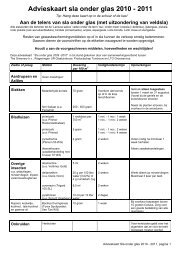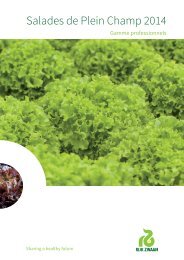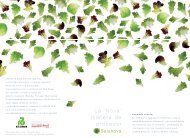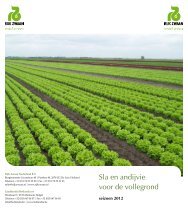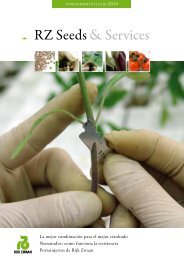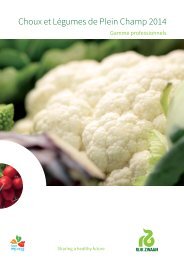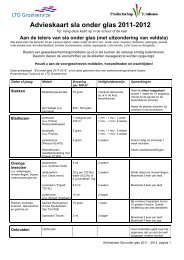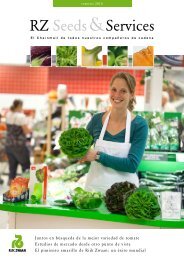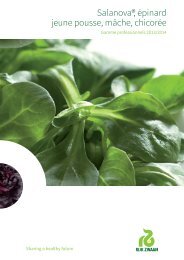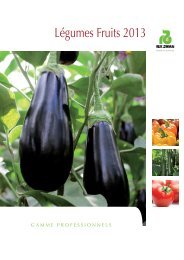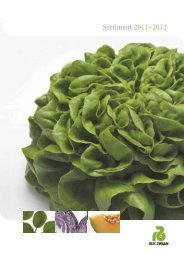Brassica Magazine 2009 - Rijk Zwaan
Brassica Magazine 2009 - Rijk Zwaan
Brassica Magazine 2009 - Rijk Zwaan
Create successful ePaper yourself
Turn your PDF publications into a flip-book with our unique Google optimized e-Paper software.
<strong>Rijk</strong> <strong>Zwaan</strong> in <strong>Brassica</strong>
Contents<br />
‘A serious player in <strong>Brassica</strong> crops’ 3<br />
<strong>Rijk</strong> <strong>Zwaan</strong> cauliflower takes up a permanent<br />
place at processors 4-5<br />
Agassi RZ feels at home in the desert 6<br />
‘Widening range for storage’ 7<br />
‘Growing... with the market’ 7<br />
<strong>Brassica</strong> Tour 2008 8-9<br />
New appeal with ‘Pointed Bio’ 10-11<br />
New and promising 12-13<br />
Early <strong>Brassica</strong>s: a specialty in South-East Europe 14<br />
‘There is so much more you can do with <strong>Brassica</strong>s’ 15<br />
<strong>Rijk</strong> <strong>Zwaan</strong> in <strong>Brassica</strong> is a publication by:<br />
<strong>Rijk</strong> <strong>Zwaan</strong><br />
P.O. Box 40, 2678 ZG De Lier<br />
The Netherlands<br />
Tel. +31 (0)174 53 23 00<br />
E-mail: rijkzwaan@rijkzwaan.nl<br />
www.rijkzwaan.com<br />
For more information:<br />
visit www.rzbrassicayear.com
‘A serious player in <strong>Brassica</strong> crops’<br />
During <strong>Brassica</strong> Year 2008, <strong>Rijk</strong> <strong>Zwaan</strong> gave extra attention to <strong>Brassica</strong>s<br />
worldwide. And with great success. The crowds in the demo fields, the positive<br />
feedback afterwards and the high expectations for the future all indicate that<br />
when it comes to <strong>Brassica</strong> crops, <strong>Rijk</strong> <strong>Zwaan</strong> is now a serious player.<br />
With no less than 25 events in 22<br />
countries, last year we put great effort<br />
in showing our assortment. A huge<br />
action but with a local approach,<br />
what made it possible to show the<br />
best assortment on every demo field,<br />
depending on the season. But there<br />
was more: expert advice, interesting<br />
lectures and appropriate buffets to<br />
exchange knowledge and experiences.<br />
In doing so we have generated a lot of<br />
enthusiasm with thousands of visitors.<br />
Continuous search<br />
We are pleased that we can really<br />
present ourselves as a <strong>Brassica</strong> com-<br />
pany now. In all <strong>Brassica</strong> segments we<br />
have varieties that perform well, where<br />
quality and crop characteristics are<br />
concerned. Looking at it internationally,<br />
we are covering an ever increasing<br />
share of the market and the search for<br />
top varieties continues unabated. After<br />
all, breeding is a continuous process<br />
and we are already growing a number<br />
of promising new varieties in trials.<br />
Ad van den Nieuwenhuizen<br />
Michael Kreitz<br />
Christian Spangenberg<br />
<strong>Rijk</strong> <strong>Zwaan</strong> in <strong>Brassica</strong> 3
Piet Baekelandt has not regretted choosing Dexter RZ ▲<br />
<strong>Rijk</strong> <strong>Zwaan</strong> cauliflower takes up<br />
a permanent place at processors<br />
When it comes to cauliflower, the processing industry is one of the major buyers. It is not surprising, then, that <strong>Rijk</strong><br />
<strong>Zwaan</strong> works hard on a range that meets the specific demands of this market, with suitable varieties for each region.<br />
As far as that is concerned, Casper RZ and Dexter RZ are top varieties and very versatile into the bargain.<br />
<strong>Rijk</strong> <strong>Zwaan</strong> works on varieties that meet<br />
the specific demands of the industry ▲<br />
Johan Decroos is account manager<br />
industrial cropping for <strong>Rijk</strong> <strong>Zwaan</strong> ▲<br />
Johan Decroos is account manager<br />
industrial cropping for <strong>Rijk</strong> <strong>Zwaan</strong>.<br />
He relates how, in the Benelux alone,<br />
about 4,000 ha of cauliflower are<br />
grown for industrial use. “So it’s only<br />
logical that <strong>Rijk</strong> <strong>Zwaan</strong> takes the<br />
demands of this market into account<br />
in its breeding programme. That is<br />
why we have selection trials, especially<br />
aimed at industrial cropping. The<br />
most successful varieties from these<br />
trials are then tried out further in a<br />
practical setting. In Spain that has<br />
been Casper for many years now<br />
and in the Benelux the industry is<br />
going for variety Dexter in a big way.<br />
In addition, our new variety Cercy<br />
RZ also performed very well for the<br />
industry in the new trials.”<br />
Pretty on a plate<br />
Dexter and Casper totally meet the<br />
wishes of the frozen-food industry<br />
in practice, Decroos continues.<br />
“The industry wants a solid, white<br />
cauliflower with a high specific<br />
gravity. Processors also like nice tight<br />
florets with a short stem. In short:<br />
the processed product needs to look<br />
good on the plate of the consumer.<br />
And these two varieties certainly do<br />
that! The florets are lovely and white,<br />
with short stems. A big advantage<br />
of Casper and Dexter is that both<br />
varieties can find their way to the<br />
consumer in different ways. They are<br />
also excellent for the fresh market and<br />
the convenience segment. The latter is<br />
especially important, as this market is<br />
experiencing enormous growth that is<br />
not going to stop soon.”<br />
Decroos: “Buyers are very happy and<br />
make permanent room for our varieties<br />
in their ranges. Due to the unique<br />
combination of traits I also expect that<br />
these varieties will retain their strong<br />
position well into the future.”<br />
4<br />
RZ brassica | <strong>2009</strong>
Processors like nice tight florets with a short stem ▲<br />
Dexter RZ: At the request of the<br />
buyer<br />
Dexter is becoming increasingly<br />
popular in big-production countries<br />
Belgium and Poland. One of the<br />
growers with experience of growing<br />
Dexter is Piet Baekelandt from<br />
Meulebeke (Belgium). “Last year we<br />
had a trial field with 15 cauliflower<br />
varieties, at the request of our buyer,<br />
Ardo. Dexter emerged as one of the<br />
best varieties, for us as growers and<br />
for our buyer. That decided us to grow<br />
1 ha of it this year.” Baekelandt has<br />
not regretted his choice. “We noticed<br />
that Dexter has great wrapper leaves.<br />
It is a vigorous cauliflower that makes<br />
leaves very easily. We like that in a<br />
cauliflower, as it saves us a lot of work.<br />
It is also a good choice quality wise:<br />
it is a heavy cauliflower that keeps its<br />
dense structure and nice white colour.<br />
The head is also filled right down to<br />
the base and the harvest percentage is<br />
high. Ardo, our buyer, was also happy.<br />
We had no problems in supplying nice<br />
florets with short stems of AA quality,<br />
perfect for the industry.”<br />
Casper RZ: Strong in different<br />
climates<br />
Around 40% of the total cauliflower<br />
market in Spain is now taken up by<br />
Casper. The success story started<br />
about 10 years ago. “This variety soon<br />
showed itself to be a real eye-catcher,”<br />
says <strong>Rijk</strong> <strong>Zwaan</strong> crop specialist José<br />
Hernandez Torres. “Initially it was<br />
discovered by the fresh market in<br />
particular, but we now know that<br />
it also has the right characteristics<br />
for the industry. The variety has<br />
enormous advantages for growers as<br />
it performs well in many different<br />
climates. Here in Spain we get some<br />
extreme conditions and Casper is<br />
unique in that it feels at home in all<br />
these conditions. To give an example:<br />
the variety is grown all over Spain in<br />
spring and autumn at altitudes ranging<br />
from 0 – 1,000 metres. In summer,<br />
on the other hand, the variety does<br />
well at 500 – 1,000 m altitude. What<br />
is also important is that both drip and<br />
channel irrigation can be used when<br />
growing Casper, which also contributes<br />
to its all-round character.”<br />
<strong>Rijk</strong> <strong>Zwaan</strong> in <strong>Brassica</strong> 5
From left to right: Mike Ennin (Coastline Sunrich),<br />
Andrew Courier (Badlands Provisions), Danny<br />
Williams and David Johnson (Gowan Seed<br />
Company) and Merek Dorf (<strong>Rijk</strong> <strong>Zwaan</strong>) ▲<br />
Agassi RZ feels at home<br />
in the desert<br />
It took several trials to find the right place to grow broccoli variety Agassi RZ.<br />
But since it was planted commercially in the desert of Arizona during the<br />
autumn of 2008 it really has started to demonstrate its advantages.<br />
One of the great advantages of Agassi RZ is its<br />
constant quality ▲<br />
The desert of Arizona proofs itself as a good<br />
place to grow Agassi RZ ▲<br />
Agassi consistently produces dense,<br />
smooth heads with a high domed<br />
shape. It is able to produce a solid<br />
plant anchored by a sturdy root<br />
system, consistently making heads<br />
with small to medium size beads and<br />
an attractive dark green colour. Talking<br />
with key growers in the desert, the<br />
consensus is that Agassi fits perfectly<br />
into their broccoli programmes, with<br />
excellent performance in normal<br />
growing conditions.<br />
One of the Agassi growers is Andrew<br />
Courier of Badlands Provisions in the<br />
Imperial Valley, supplied by Gowan<br />
Seed Company. For him, the main<br />
advantages are the long sowing period<br />
and the consistent quality Agassi<br />
produces. “Agassi has more continuity<br />
in harvest. Instead of relying on two or<br />
three products to cover all the harvest<br />
slots, I can use Agassi throughout<br />
the harvest period from late January<br />
through early March. By sticking<br />
with Agassi for a longer time, I leave<br />
no varietal gap.” Due to the consistent<br />
quality Agassi maintains during<br />
harvest, Badland Provisions is able to<br />
harvest Agassi for export as well as for<br />
domestic markets. “Whether it’s for<br />
crowns, florets, bunches or the special<br />
Coastal Sunrich iceless vacuum-sealed<br />
product, Agassi gives me a lot of flexibility<br />
in marketing the product.”<br />
The direct-drilled fields in the desert,<br />
which are mostly irrigated by furrow<br />
and drip irrigation, create a perfect<br />
environment for Agassi, Courier<br />
concludes. “It feels at home, which<br />
really helps in enhancing its wonderful<br />
characteristics.”<br />
6<br />
RZ brassica | <strong>2009</strong>
Germany<br />
’Widening range for storage’<br />
Storage cabbage is an important<br />
segment within <strong>Brassica</strong>s and as<br />
a result gets a lot of attention in<br />
the breeding work of <strong>Rijk</strong> <strong>Zwaan</strong>.<br />
Christian Spangenberg is coordinating<br />
the international Headed Cabbage<br />
activities at <strong>Rijk</strong> <strong>Zwaan</strong>:<br />
“At our Marne breeding station we<br />
have a special location for storage<br />
evaluation, combining field results<br />
with practical storage tests because<br />
only the final check after 5 – 9 months<br />
in ambient or cold-store conditions<br />
will reveal the realistic value and marketing<br />
options of a new hybrid. It is<br />
very important to harvest the cabbages<br />
per weight classification, since growers<br />
require very detailed information<br />
about the options they get with an<br />
expensive long-stored product.”<br />
In February 2008 <strong>Rijk</strong> <strong>Zwaan</strong> was<br />
proud to welcome over 600 regional<br />
and international guests to the<br />
<strong>Brassica</strong> Year event in Marne. A great<br />
opportunity to talk to other specialists<br />
and learn about new developments in<br />
the business.<br />
“Technical solutions, growing concepts<br />
and naturally the newly-launched<br />
varieties drew quite some attention,”<br />
Spangenberg noticed. “Storema RZ<br />
for example has gained very quickly in<br />
significance in all the regions for storage<br />
cabbage in Europe and continues<br />
to gain market shares. Furthermore,<br />
‘all-rounders’ like Ancoma RZ are<br />
moving successfully into international<br />
storage areas, widening the <strong>Rijk</strong> <strong>Zwaan</strong><br />
Marne range first of all in eastern<br />
Europe.”<br />
In <strong>2009</strong> another storage event took<br />
place with, as one of the impressive<br />
winners, Mucsuma (30-256) RZ, a<br />
high yielder for the large segments<br />
with processing value. Spangenberg:<br />
“Depending on the growing system<br />
you can expect 5 kg head weights<br />
in the late harvesting season, or<br />
long-term storage quality within the<br />
3 – 4 kg range. Mucsuma performed<br />
especially well at our continental trial<br />
locations in Hungary and Russia. We<br />
expect to take the storage varieties<br />
from Marne way beyond their native<br />
origins.”<br />
At the Marne breeding station, special<br />
attention is given to storage evaluation ▲<br />
Italy<br />
‘Growing… with the market’<br />
Kohlrabi is one of the first crops<br />
developed by <strong>Rijk</strong> <strong>Zwaan</strong> for the<br />
Italian market. Even after fifteen<br />
years, it remains one of the main crops<br />
in the <strong>Brassica</strong> range. In pursuing this<br />
aim, <strong>Rijk</strong> <strong>Zwaan</strong> has been involved in<br />
the growth of this species in Italy, says<br />
<strong>Rijk</strong> <strong>Zwaan</strong> crop specialist Alessandro<br />
Silvestrelli (left) and Alfonso Nocera of<br />
Agrinocera ▲<br />
crop specialist Alessandro Silvestrelli:<br />
“In fact, it went from being a fairly<br />
unknown type of cabbage, with its<br />
first appearances in the Latina area,<br />
to being one of the most widely<br />
cultivated crops in Italy for export<br />
to other European countries. Over<br />
recent years our main commitment<br />
has always been to try and understand<br />
the crop how it is now, but also how<br />
it may possibly evolve in the future.<br />
This kind of approach has enabled<br />
us to come up with an innovative<br />
type of breeding, presenting the first<br />
male-sterile varieties on the market.<br />
Furthermore, we introduced genetic<br />
characteristics including vigour and<br />
upright position of the leaves and the<br />
length of the hypocotyls, lifting the<br />
bulb and consequently reducing the<br />
impact of soil diseases.”<br />
“Our work aims not only to develop<br />
high-profile genetic material, but at<br />
the same time to share our experience<br />
with the grower,” Silvestrelli<br />
continues. “The kohlrabi crop has<br />
grown so quickly, but is still young<br />
and its physiological, nutritional and<br />
health-related characteristics are still<br />
fairly little known. By studying and<br />
carrying out research together we want<br />
to continue along our successful path<br />
of cooperation.”<br />
Silvestrelli expects that further<br />
exploration of the kohlrabi species<br />
will present new challenges. “With our<br />
experience and leadership we will be<br />
able to tackle these challenges. I am<br />
convinced that constant work in the<br />
field, including information exchanges<br />
and tests, will remain the winning<br />
force for us.”<br />
<strong>Rijk</strong> <strong>Zwaan</strong> in <strong>Brassica</strong> 7
A great year<br />
‘These are the <strong>Rijk</strong> <strong>Zwaan</strong> <strong>Brassica</strong>s’<br />
After many years of breeding work, last year the time had come to show<br />
the world what <strong>Rijk</strong> <strong>Zwaan</strong> has to offer in <strong>Brassica</strong>s. Along the <strong>Brassica</strong><br />
Tour 2008 thousands of growers, merchants, processors, retailers,<br />
journalists and university representatives from home and abroad had<br />
visited the various demo fields. <strong>Rijk</strong> <strong>Zwaan</strong> would like to thank all the<br />
guests for their input and individual support during the RZ <strong>Brassica</strong> Year.<br />
8<br />
RZ brassica | <strong>2009</strong>
<strong>Rijk</strong> <strong>Zwaan</strong> in <strong>Brassica</strong> 9
New appeal with ‘Pointed Bio’<br />
Behr AG in Ohlendorf (Germany) is a Europe-wide operating salad producer, always looking for novelties and now<br />
entering <strong>Brassica</strong> crops with its own marketing concept BIO BÄR. A successful example is green pointed cabbage<br />
Sonsma RZ, which provides a lot of opportunities for marketing the product.<br />
As long ago as in the autumn of 2006,<br />
<strong>Rijk</strong> <strong>Zwaan</strong> had stimulating discussions<br />
with Rudolf Behr about novelties<br />
in <strong>Brassica</strong> crops in the Opperdoes<br />
RZ trial fields in Noord-Holland.<br />
Eventually, the project with Sonsma<br />
was started in Portugal, where Behr<br />
AG (AMG Agrar Management GmbH)<br />
trialled it as a premium product,<br />
supplying from February / March, just<br />
in time for the early market season<br />
in Germany. The trials were a success<br />
and eventually led to completely new<br />
prospects. Sonsma clearly surpassed<br />
the other early varieties, round or<br />
pointed, in terms of taste. As a result,<br />
50 ha of Sonsma were launched in<br />
Germany in 2008 as part of the BIO<br />
BÄR concept. At the moment its taste<br />
is even regarded as the standard for<br />
new pointed cabbage varieties.<br />
Revival of <strong>Brassica</strong>s<br />
Dr. Georg Mevenkamp, who coordinates<br />
all growing schedules and<br />
new projects within Behr AG (AMG<br />
Agrar Management GmbH), explains<br />
more about this concept, which also<br />
includes cauliflower and broccoli: “A<br />
new appeal for traditional vegetable<br />
crops is necessary. The demand for<br />
light and healthy nutrition requires<br />
products of high value. Taste issues<br />
Success through cooperation<br />
The success of the Sonsma project is a good example of the<br />
cooperation between <strong>Rijk</strong> <strong>Zwaan</strong> and growers. By exchanging<br />
breeding developments and thoughts on marketing issues,<br />
new successful products can emerge. <strong>Rijk</strong> <strong>Zwaan</strong> and Behr<br />
are also looking for retail partners who reach large numbers<br />
of consumers and feel dedicated to fresh products. For <strong>Rijk</strong><br />
<strong>Zwaan</strong> it is a rewarding challenge to develop reliable, fastgrowing<br />
varieties, delivering the premium qualities of the entire<br />
food-producing chain. The next generation of test hybrids from<br />
<strong>Rijk</strong> <strong>Zwaan</strong> will, therefore, be available soon. Behr himself will<br />
move RZ novelty 30-252 RZ into test production, expecting<br />
even better compactness.<br />
From left to right: Christian Spangenberg, <strong>Rijk</strong> <strong>Zwaan</strong> <strong>Brassica</strong><br />
specialist, Dr. Georg Mevenkamp, Behr AG (AMG Agrar<br />
Management GmbH) and Georg Karancsi, product advisor<br />
<strong>Rijk</strong> <strong>Zwaan</strong><br />
10<br />
RZ brassica | <strong>2009</strong>
With new packing and cooling facilities, Behr AG is able to optimise its logistics. This<br />
contributes to a quality product at the end of the chain. ▲<br />
need a revival, organic qualities are<br />
affordable today. Especially <strong>Brassica</strong><br />
crops still suffer from an image as vegetables<br />
that need a long cooking time,<br />
with laborious preparation. That’s why<br />
we launched the BIO BÄR concept,<br />
which is tailor-made for Sonsma.“<br />
For Sonsma, Behr defined two<br />
different market segments: single<br />
packs for the fresh market with a<br />
maximum weight of 1 kg per head and<br />
a ‘trendy veg’ for use in the microwave<br />
as a double pack, with single head<br />
weights of 400 g. The microwavable<br />
BIO pointed cabbage is a real<br />
innovation, attractively presented in<br />
special microwave plastic. “An acute<br />
awareness of consumer needs and<br />
expectations is important, especially<br />
with organic marketing. Sustained<br />
demand is generated from the taste<br />
experience. With BIO BÄR we also<br />
want to initiate “live tastings” this year<br />
at the point of sale, to get in direct<br />
contact with consumers.”<br />
Controlled chain<br />
The actual production planning for<br />
the BIO BÄR location in Gresse<br />
(south-east of Hamburg) is around 170<br />
ha of <strong>Brassica</strong> crops, produced according<br />
to European guidelines for organic<br />
crops. Within two hours the harvested<br />
product is cooled and packed, guaranteeing<br />
a refrigerated chain to each<br />
marketing partner. The new packing<br />
and cooling facilities<br />
in Ohlendorf will<br />
optimise the existing<br />
logistics of Behr<br />
AG even further.<br />
Mevenkamp: “Top<br />
quality in organic<br />
production of<br />
pointed cabbage is<br />
achieved by planting<br />
Sonsma throughout the<br />
season under insect netting,<br />
with a plant density of around<br />
50,000 plants/ha. Mechanical<br />
weeding and overhead irrigation<br />
are basic requirements for<br />
production. Using a slow-release<br />
fertiliser results in a cabbage crop<br />
with an excellent field performance, a<br />
strong cell structure and intensive wax<br />
layering. This approach also provides<br />
a longer harvesting period. Altogether,<br />
Sonsma is a truly appealing variety, for<br />
marketing as well as for<br />
growing.”<br />
<strong>Rijk</strong> <strong>Zwaan</strong> in <strong>Brassica</strong> 11
New and promising<br />
Our plant breeding efforts in Marne, Fijnaart and La Palma ensure the continuous widening and deepening of our<br />
range. Below is an overview of a number of promising newcomers which have prompted many enthusiastic reactions<br />
from the commercial world. Enthusiasm for an attractive presentation, yield reliability, high productions and more.<br />
Varieties all with at least one thing in common: a promising future.<br />
Cauliflower<br />
Vitaverde<br />
Year-round speciality<br />
Vitaverde is the first green cauliflower<br />
variety that can be grown year-round:<br />
in winter in subtropical or Mediterranean<br />
conditions and for the remainder<br />
of the year in temperate climates. The<br />
crop is vigorous and upright-growing.<br />
The heads are tolerant to bracting and<br />
riciness.<br />
Castellum RZ (26-158 RZ)<br />
Perfect for late autumn<br />
A strong and vigorous autumn variety<br />
that performs well especially in late<br />
autumn. When growing conditions<br />
are slow and light intensity is low, this<br />
variety comes into its own. The white,<br />
solid head gets very good cover from<br />
the wrapper leaves. This variety grows<br />
very upright, making it very easy to<br />
harvest.<br />
Miramonte RZ (26-165 RZ)<br />
Fast grower<br />
With a crop cycle of 56 – 70 days,<br />
Miramonte is a fast grower. In spring<br />
the variety is very suitable for the<br />
temperate central and northern European<br />
conditions. Given subtropical or<br />
Mediterranean conditions, Miramonte<br />
performs very well in early autumn,<br />
too. Presentation is always excellent<br />
under all circumstances.<br />
Magister RZ (26-150 RZ)<br />
All-rounder<br />
‘A vigorous crop that feels at home in<br />
different conditions’ is the best way<br />
to describe Magister. In summer the<br />
variety performs well in temperate<br />
climates and in spring and summer it<br />
can also be grown very successfully<br />
in subtropical conditions. Its large<br />
wrapper leaves and nicely rounded,<br />
white head complete the picture.<br />
Cercy RZ (26-220 RZ)<br />
Stable and reliable<br />
Just like Casper RZ, Cercy is a stable<br />
and crop-reliable variety. Compared<br />
with Casper the crop is more vigorous<br />
and the crop cycle is about 5 days<br />
longer. Cercy does well when given<br />
high temperatures but, thanks to its<br />
vigour, is better able than Casper<br />
to cope with relatively cold conditions.<br />
The first trials for industry are<br />
promising.<br />
26-849 RZ<br />
Strong and healthy Romanesco<br />
A variety that performs well in<br />
autumn and winter. Its strong resistance<br />
to Mycosphaerella and white<br />
blister provides a lot of yield reliability<br />
for growers. The healthy crop gives a<br />
solid head after 120 days. 26-849 gives<br />
a good production and is suitable for<br />
the processing industry.<br />
12<br />
RZ brassica | <strong>2009</strong>
Broccoli<br />
25-59 RZ<br />
Small florets<br />
In subtropical and Mediterranean<br />
conditions this is a real top variety in<br />
spring. Its high resistance to downy<br />
mildew is a very big plus point while<br />
it is growing, and its high weight and<br />
small florets are great selling points.<br />
Red cabbage<br />
28-301 RZ<br />
Stress proof<br />
An interesting, new variety for early<br />
season as well as for continuous plantings<br />
year-round.<br />
28-301 adapts easily to different or<br />
extreme climate conditions, offering a<br />
long harvesting period. The well-filled<br />
heads develop a nice round shape,<br />
offering a weight range from 1 – 2 kg.<br />
Its intensive red colouring and short<br />
core satisfy consumer demands.<br />
Rexoma RZ<br />
Reliable and well-rounded<br />
Rexoma offers a lot of yield reliability<br />
and, late in the season, a uniform<br />
crop in all the traditional cabbage<br />
countries. It gives a compact head and<br />
is interesting to all sales channels,<br />
including the stored-cabbage market.<br />
This multi-purpose red cabbage has a<br />
nice round head shape, with internal<br />
values like a well-balanced red-white<br />
contrast and limited bleeding.<br />
White cabbage<br />
Zuleima RZ<br />
Versatile<br />
A versatile, oblate variety that can<br />
be used in various ways. Suitable<br />
for processing as sauerkraut or as a<br />
fine ingredient in fresh salads. The<br />
vigorous growing habit can realize<br />
head weights of up to 6 kg, but there<br />
are sales options within the 2.5 – 3.5<br />
kg category as well. The slow internal<br />
filling is very much appreciated by<br />
both growers and end-users.<br />
Mucsuma RZ<br />
Suitable for the processing<br />
industry<br />
This new variety covers an extended<br />
sales period, ranging from late season<br />
to well into marketing from storage.<br />
Strong vigour and reliable field performance<br />
under stress are important<br />
values for growers, ensuring them a<br />
strong partnership with the processing<br />
industry. Mucsuma combines a safe<br />
yield potential with top fresh-cut<br />
qualities such as a uniform leaf<br />
structure and high output.<br />
Savoy<br />
Morama RZ<br />
High dry-matter content<br />
In between savoy and white cabbage,<br />
this variety is suitable for the fresh<br />
market, industrial and convenience<br />
segments. Due to its high drymatter<br />
content it is eminently suited<br />
to desiccation. Morama shows waxy<br />
dark green leaves and is strong against<br />
thrips. Its vigorous but slow growing<br />
habit gives interesting options for<br />
overwintering areas and extreme<br />
climate conditions.<br />
Kohlrabi<br />
Eltville RZ<br />
Easy harvesting<br />
This new variety impresses in summer<br />
and autumn. The crop has a lot of<br />
vigour and with its nicely rounded<br />
bulb shape and smooth skin, presentation<br />
is excellent. Eltville has strong<br />
and long hypocotyls, contributing to<br />
the bulbs’ healthy base and making<br />
them easy to harvest.<br />
Siret RZ (32-007 RZ)<br />
Strong in winter<br />
This variety is suitable for southern<br />
European winter production. Its high<br />
resistance to mildew and vigorous,<br />
upright crop offer growers big advantages<br />
when growing conditions are less<br />
than perfect.<br />
<strong>Rijk</strong> <strong>Zwaan</strong> in <strong>Brassica</strong> 13
<strong>Rijk</strong> <strong>Zwaan</strong> varieties for early cultivation<br />
drew a lot of attention during the <strong>Brassica</strong><br />
event in Hungary.<br />
▲<br />
Early <strong>Brassica</strong>s: a speciality<br />
in South-East Europe<br />
One of the very successful <strong>Rijk</strong> <strong>Zwaan</strong> <strong>Brassica</strong> events in 2008 was the one<br />
in Hungary, where in the first week of May more than 300 growers from 7<br />
countries followed the invitation. This was not only a signal of great interest,<br />
but also an appreciation to RZ varieties.<br />
Some varieties show their full market<br />
potential in tunnel production<br />
Early white cabbage is popular in<br />
countries like Hungary, the Balkans<br />
and Ukraine, where they consume and<br />
export it fresh, for salads. Growers<br />
produce it under unheated plastic<br />
tunnels, and transplant between<br />
January and March, depending on the<br />
areas. Special growing needs special<br />
attention, we believe at <strong>Rijk</strong> <strong>Zwaan</strong>.<br />
Therefore we decided to focus a<br />
special breeding activity to this market<br />
segment. Our Trial Station in Felgyö<br />
(Hungary) acts as the main centre for<br />
early <strong>Brassica</strong> trials, and demos.<br />
During the <strong>Brassica</strong> event in Felgyö,<br />
on different locations we showed<br />
plastic tunnels with variety trials, different<br />
plant densities, mini tunnels in<br />
the open field, and crops covered by<br />
fleece. László Ragyák is crop specialist:<br />
“The early white cabbage Jetma RZ<br />
was the main focus for Macedonian,<br />
Romanian, and Ukrainian growers.<br />
The followers Rayma RZ and Adema<br />
RZ performed also well, depending<br />
on the market demands. While the<br />
Serbian and Croatian guests especially<br />
liked the dark green coloured Adema,<br />
for the Romanian colleagues the fresh<br />
green Rayma was the most popular<br />
one.”<br />
Different technical solutions of crop<br />
covering offer interesting alternatives<br />
to the growers to achieve better<br />
earliness, which is essential, explains<br />
Ragyák “Our demo went into details<br />
about the right cultivation technique,<br />
because we want to support our<br />
customers in finding the right way<br />
of growing. Through discussions we<br />
also receive feedback about our new<br />
hybrids. This gives us new energy and<br />
inspiration to breed those varieties,<br />
which are needed for the most<br />
successful cultivation in this specific<br />
segment.”<br />
Different mulch materials and irrigation<br />
systems in test<br />
International guests entering the Felgyö<br />
trial station<br />
14 RZ <strong>Brassica</strong> | <strong>2009</strong>
▲<br />
Innovation expert Corrinne Goenee<br />
‘There is so much more<br />
you can do with <strong>Brassica</strong>s’<br />
<strong>Brassica</strong>s are popular around the globe, but there is still a whole world to be won. By giving consumers new ideas and<br />
a better experience, but also by thinking up new solutions. Product development by means of plant breeding can play a<br />
significant role in this.<br />
It is part of <strong>Rijk</strong> <strong>Zwaan</strong>’s innovative<br />
appeal to let itself be inspired by<br />
experienced trend watchers like innovation<br />
expert Corrinne Goenee. Her<br />
advice bureau ‘White Tree’ specialises<br />
in marketing and innovation in the<br />
area of food. She has also noticed that<br />
cabbage is bought more and more<br />
by consumers as a pre-cut product.<br />
Nice and easy, but she is nevertheless<br />
convinced that there are still many<br />
opportunities for cabbage as a fresh<br />
product. “<strong>Brassica</strong>s have everything.<br />
They are healthy and nutritious and<br />
can be used in so many ways: boiled<br />
or stir-fried, as a solid base for a meal<br />
or as part of a light diet. Use it in<br />
traditional recipes or try something<br />
unusual. What other vegetables are so<br />
versatile! The only thing is that these<br />
possibilities are not communicated<br />
enough at the moment.”<br />
Bringing pleasure<br />
In recent years, Goenee has seen a<br />
striving for a better quality of life in<br />
less time. “People want to enjoy the<br />
good things in life and eating well is<br />
part of that. Not just because it helps<br />
you to feel better and fitter, but also<br />
because you can make food preparation<br />
into something enjoyable. Fresh<br />
ingredients and modern preparation<br />
methods are bringing back the<br />
pleasure you can get from cooking and<br />
eating. Convenience is still appreciated<br />
but it has to be combined with health<br />
and flavour. More attention, less<br />
effort: that is the modern way of home<br />
cooking.”<br />
The development of new vegetables<br />
can stimulate and support this<br />
development further, Goenee thinks.<br />
“Looking at the future I see cabbage<br />
crops in all sorts of new colours,<br />
shapes and leaf structures emerging,<br />
with real added value. Together with<br />
traditional values, like shelf life and<br />
health, and exciting recipes, a real<br />
treasure can be re-discovered.”<br />
Telling a story<br />
From a marketing perspective,<br />
emotions can be used to modernise<br />
the partly boring image that <strong>Brassica</strong>s<br />
seem to have, continues Groenee:<br />
“<strong>Brassica</strong>s are ideal for evoking an<br />
emotion; making a product into a<br />
concept. For instance, red cabbages<br />
harvested in a field could be associated<br />
with rosy cheeks from fresh air activities.<br />
That fits in with the emotional<br />
world of mothers who want the best<br />
for their children.”<br />
All <strong>Brassica</strong> crops are naturally healthy<br />
products and may well contain extra<br />
phytochemicals or even medicinal<br />
substances to be identified in the<br />
near future. But even then, Goenee<br />
concludes, it will need a story. “For<br />
example, children would not need<br />
to eat as much of it for it to have the<br />
same effect. Vegetables can be made<br />
into a brand with unique characteristics,<br />
a convincing story and plenty<br />
of marketing opportunities. There<br />
is still a whole world to be won with<br />
<strong>Brassica</strong>s. I’m convinced of it.”<br />
<strong>Rijk</strong> <strong>Zwaan</strong> in <strong>Brassica</strong> 15
www.rzbrassicayear.com



